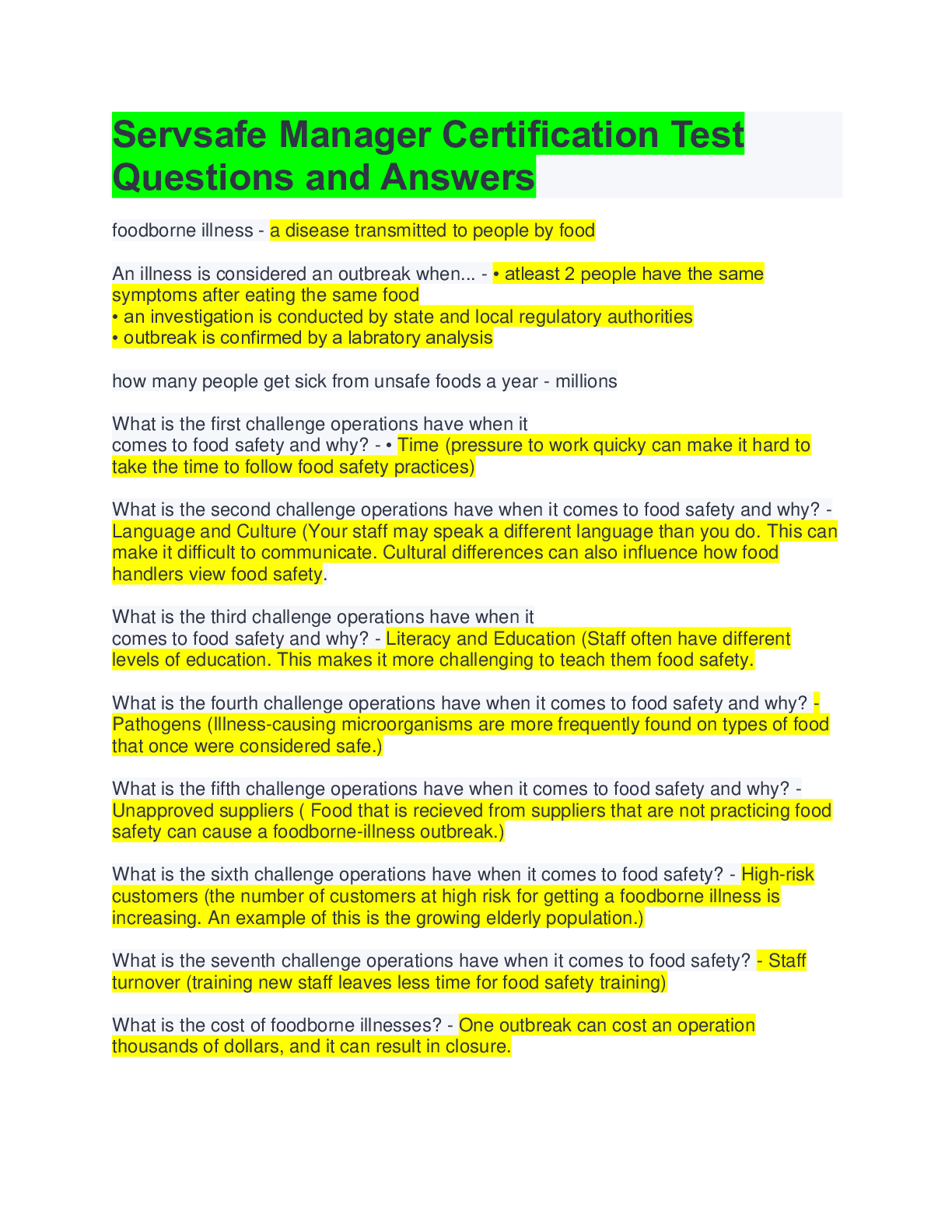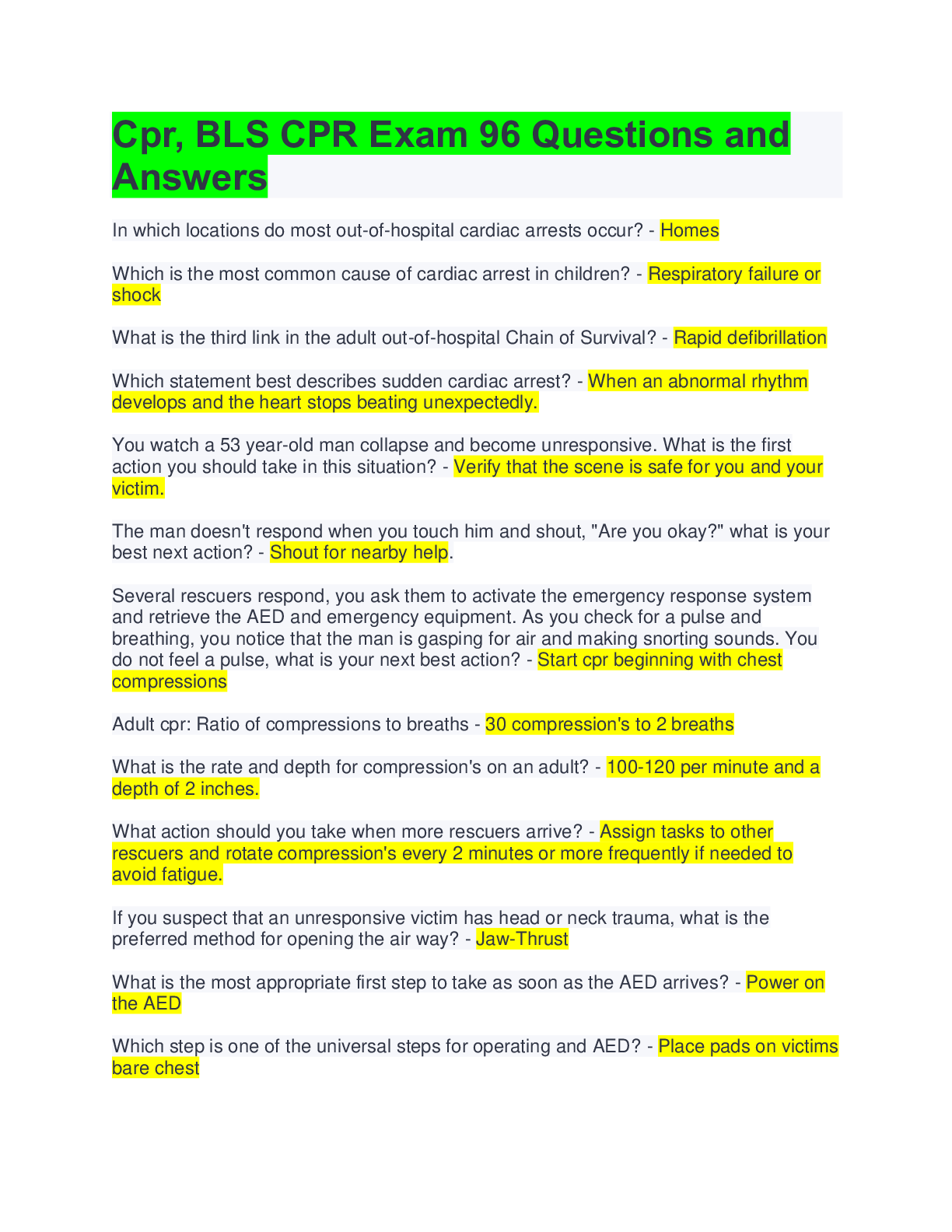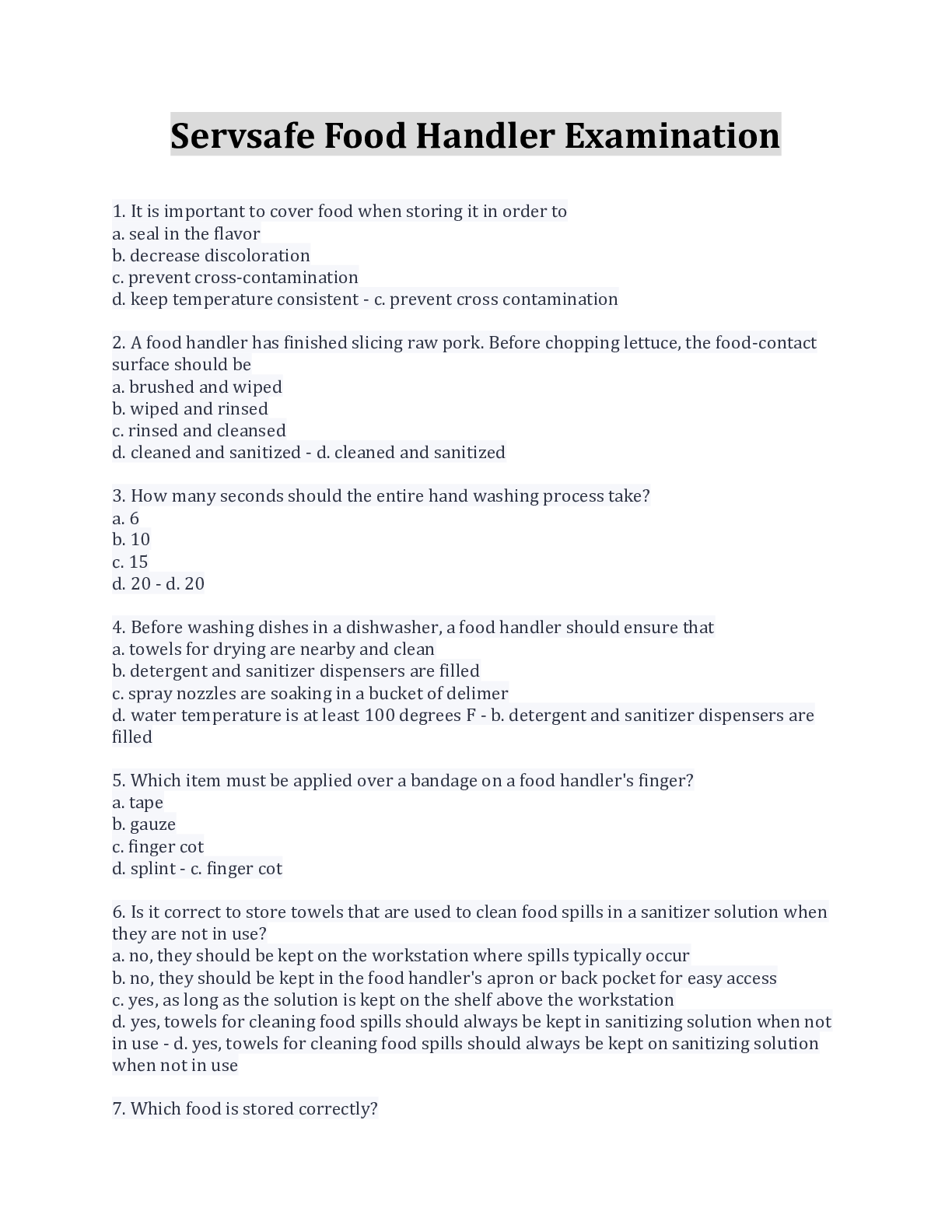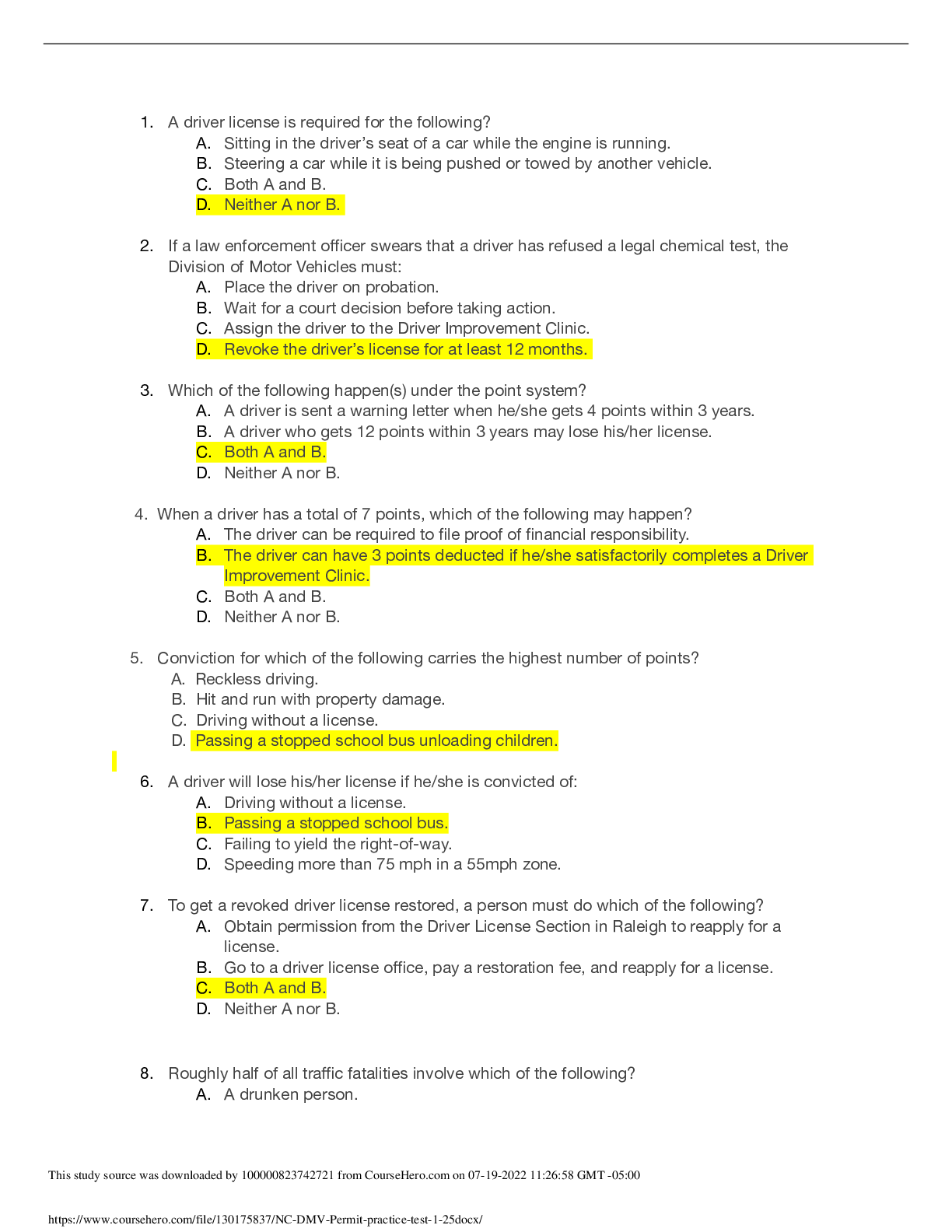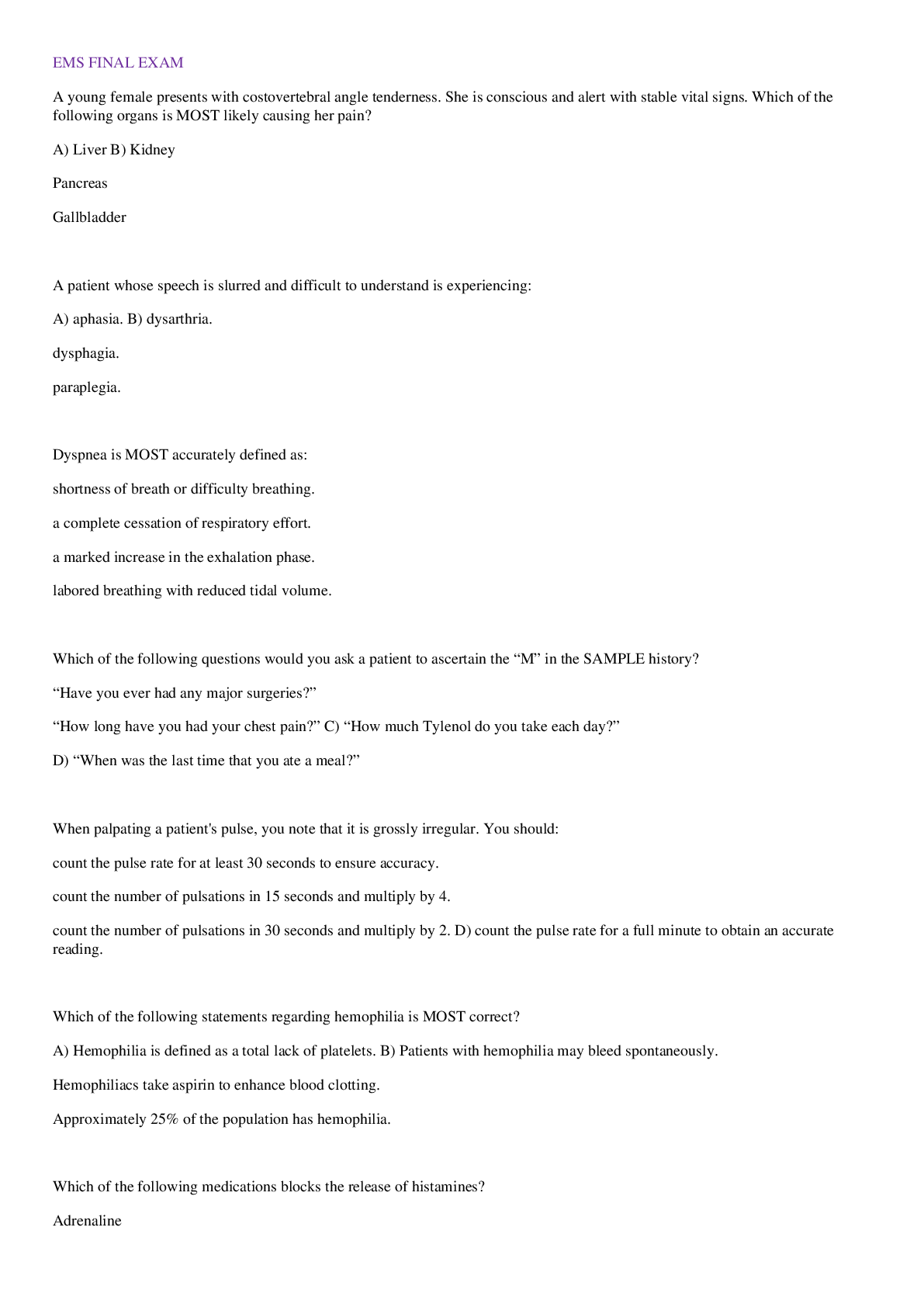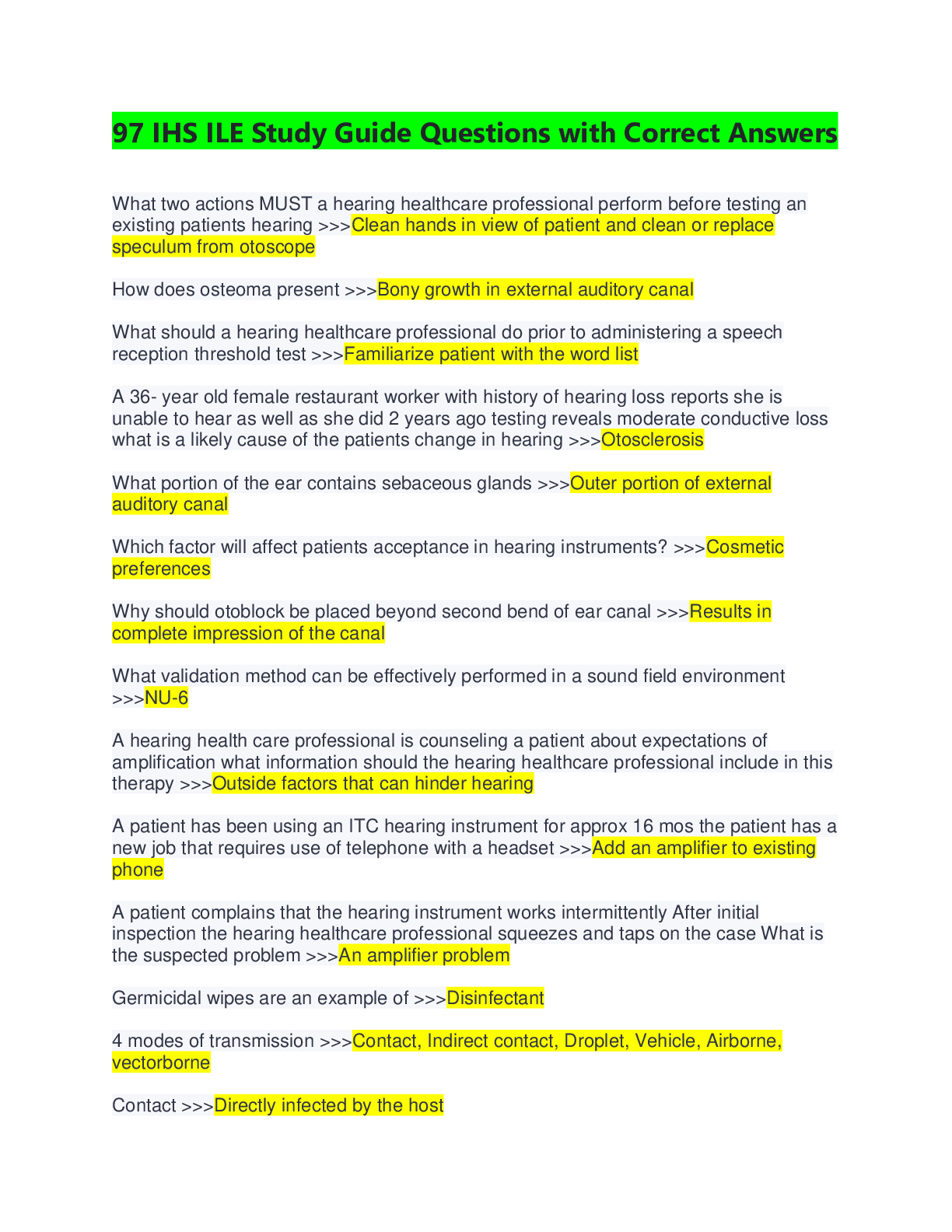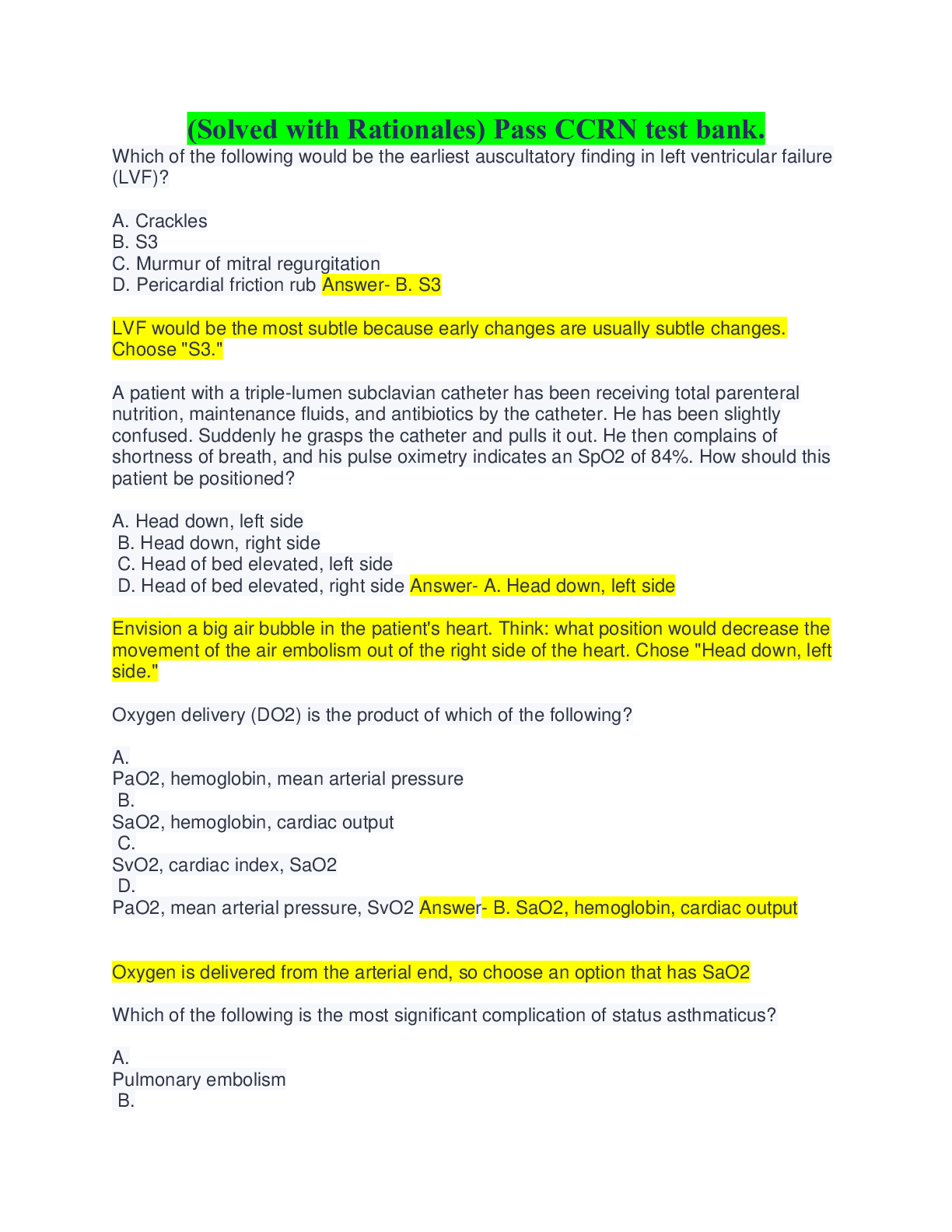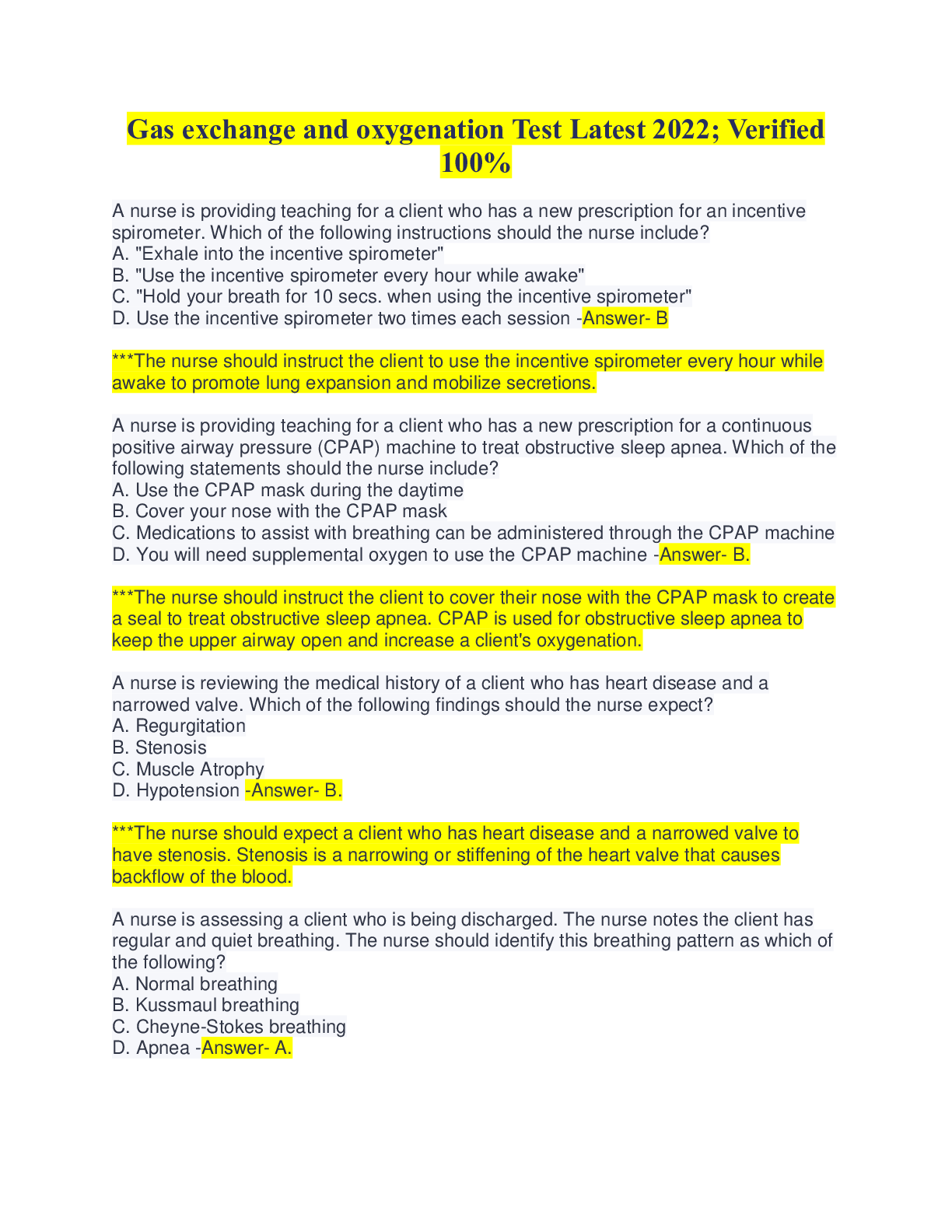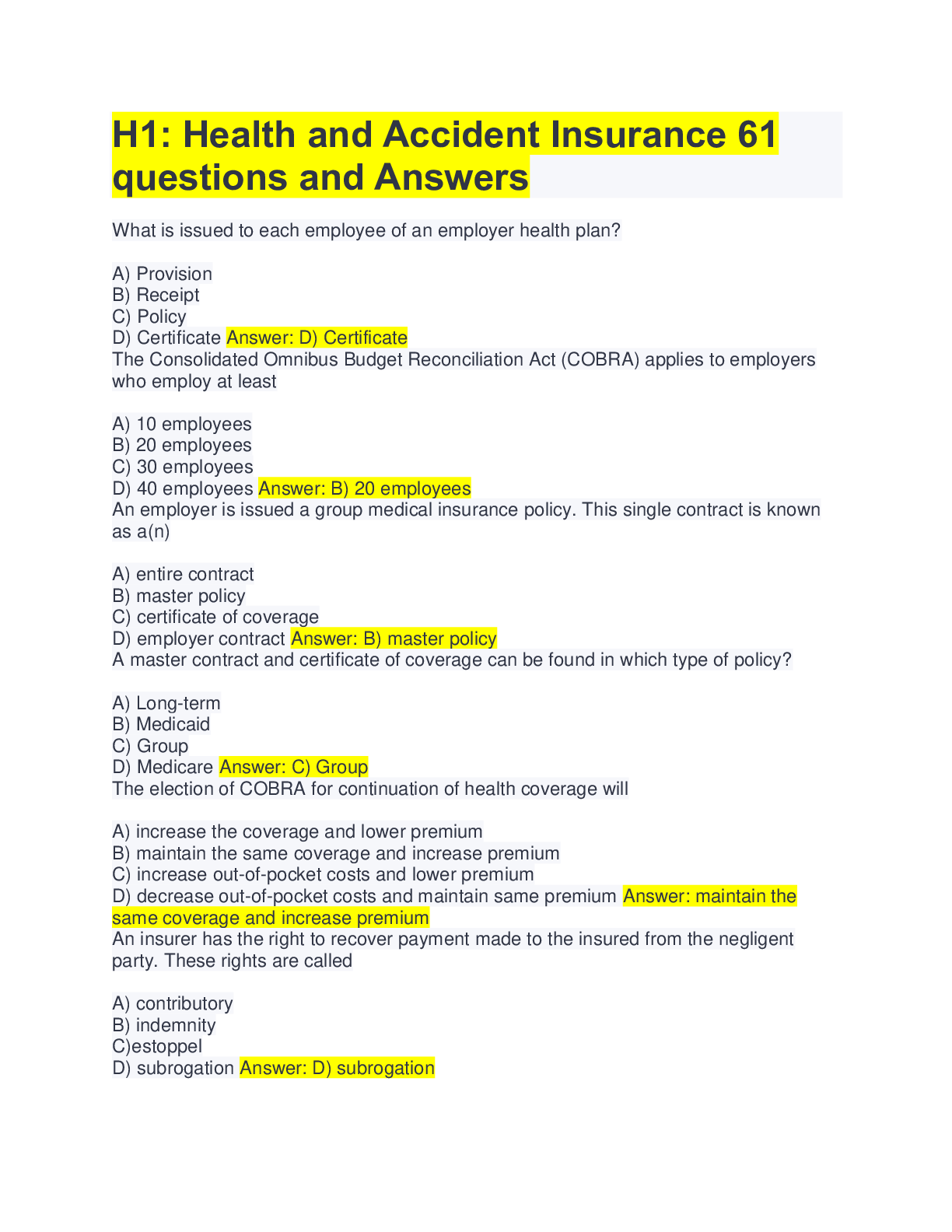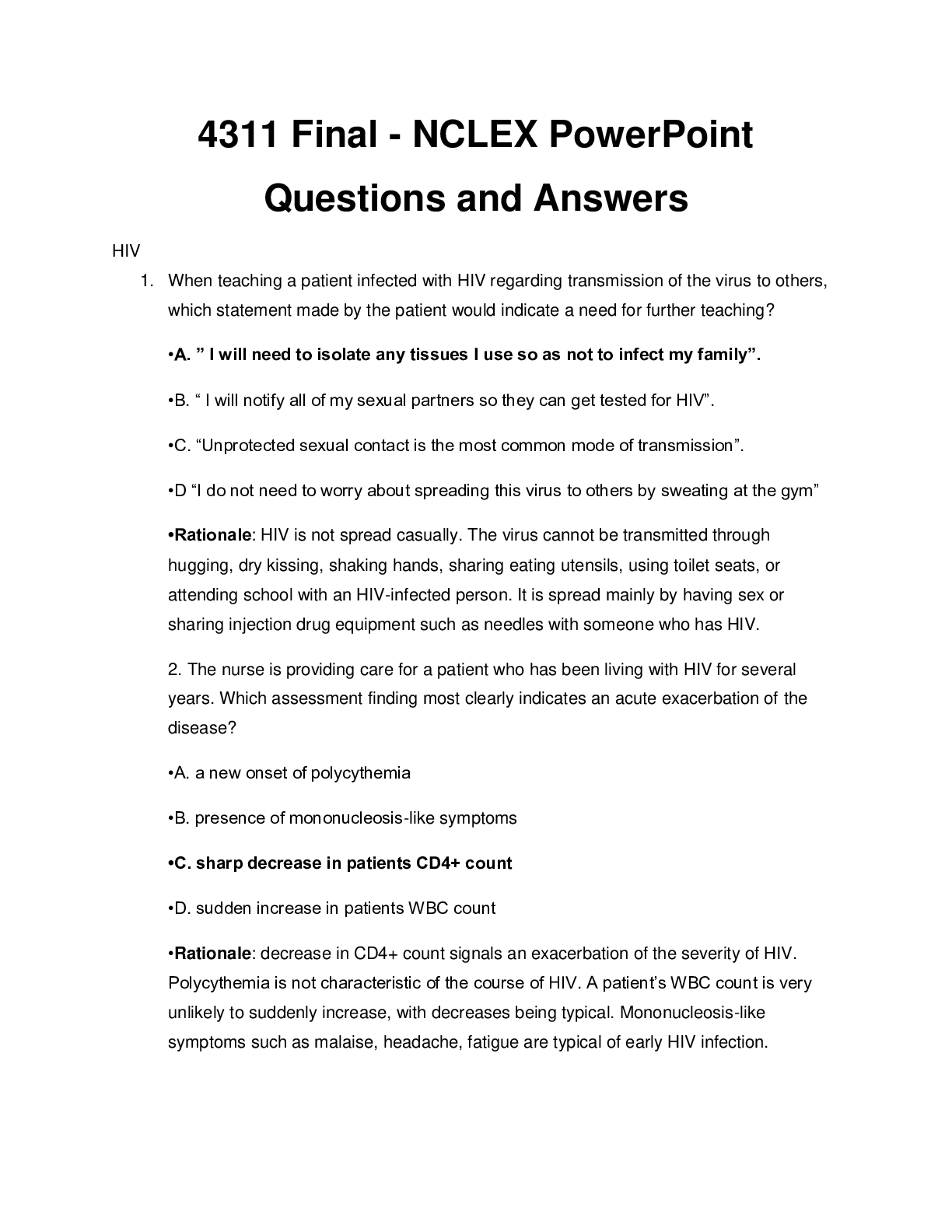*NURSING > QUESTIONS & ANSWERS > CCRN PEDS Cardiovascular 2022 Questions and Answers With rationale (All)
CCRN PEDS Cardiovascular 2022 Questions and Answers With rationale
Document Content and Description Below
CCRN PEDS Cardiovascular 2022 Questions and Answers With rationale 1. Your pediatric patient has the following parameters HR 80 BP 100/60 SV 40 BSA 0.9 m2 The cardiac index (CI) for this patien... t is A. 4.4 L/min B. 3.2 L/min/m2 C. 3.5 L/min/m2 D. 3200 mL/m2-Ans- C. The cardiac index for this patient is 3.5. First, you must calculate the cardiac output (HR X SV) or (80 X 40 =3200 = 3.2 L/min). Then, use the following equation: (CI = CO/BSA) or (3.2/0.9 = 3.55 L/min/m2) The CI is a more specific indicator of hemodynamic status than cardiac output. The CO has a broader range of 4 to 8 L/min. To make a numbers specific to an individual, the person's body surface area is included in the equation. Then the normal range becomes 2.5-4.0 L/min/m2 2. Calculate the cardiac output for a 16 year old patient with a heart rate of 72 and a stroke volume of 70 mL A. 55% B. 5.04 L/min C. 504 mL/min D. 1.02 L/min-Ans- B. Normal cardiac output for a 16 year old should be in the range of 4 to 8 L/min. The formula for calculating this value is CO = HR x SV. In this case, 72 (HR) x 70 (SV) = 5040 mL/min. Converted to liters, the answer would equal 5.04 L/min. 3. What is the mean arterial pressure for a patient with a blood pressure of 110/50 and a heart rater of 80 A. 80 B. 70 C. 50 D. 60-Ans- B. The MAP is a mean pressure that takes into account the fact that the diastolic phase represents two-thirds of the cardiac cycle. It is calculated as follows: MAP = (2(DBP) + (SBP))/3. If you took the average of the two pressures only, it would not account for the importance of the diastolic phase. The HR is not entered into this calculation. Patients should maintain a MAP of at least 60 mmHg to ensure adequate perfusion to the brain and kidneys.4. Which of the following percentages would be considered a normal value for an ejection fraction (EF)? A. 25% B. 35% C. 40% D. 60%-Ans- D. The ejection fraction should be over 50%. This is the amount of blood ejected from the left ventricle compared to the total amount available. This amount is expressed as a percentage. For example, if the ventricle contains 90 mL of blood and 50 mL is ejected, the amount would be represented as a percentage--in this case, 55%. An ejection fraction of 35% or less indicates a problem with contractility, outflow, or filling. 5. The ejection fraction (EF) most closely represents which of the following hemodynamic parameters A. RVEDP B. PAOP C. RVP D. LVEDP-Ans- D. The ejection fraction (EF) most closely represents left ventricular end-diastolic pressure (LVEDP). EF and LVEDP are closely related. The LVEDP is the volume of blood under pressure left after the end of contraction. 6. Tetralogy of Fallot manifests itself by which of the following combinations of defects? A. VSD, overriding aorta, pulmonary stenosis, and right ventricular hypertrophy B. Aortic stenosis, atrial septal defect, coarctation of the aorta, and PDA C. ASD, mitral prolapse, PDA, and pulmonary stenosis D. Mitral stenosis, PDA, ASD, and coarctation of the aorta-Ans- A. Tetraology of Fallot manifests itself by the following combinations of defects: VSD, overriding aorta, pulmonary stenosis, and right ventricular hypertrophy. This condition results in low oxygenation of blood due to the mixing of oxygenated and deoxygenated blood in the left ventricle via the VSD and mixing of blood from both ventricles through the aorta because of the obstruction to flow through the pulmonary valve. The end result is a left to right shunt. The primary symptom of tetralogy of Fallot is low blood oxygen saturation, with or without cyanosis, from birth or developing in the first year of life. If the baby is not cyanotic, then the condition is sometimes referred to as "pink tet." Other symptoms include a harsh grade II to IV systolic murmur with a thrill, difficulty in feeding, failure ot gain weight, retarded growth, physical development. Polycythemia may be present with dyspnea on exertion, along with clubbing of the fingers and toes. Children with TOF may exhibit "tet spells." The precise mechanism of these episodes is unknown, but they may result from a transient increase in resistance to blood flow to the lungs along with increased flow of desaturated blood to the body. Tet spells may be precipitated by activity and are characterized by paroxysms of hyperpnea, irritability, prolonged crying, increasing cyanosis, and decreasing intensity of the heart murmur.Tet spells may result in hypoxic brain injury and death. Older children may squat during a tet spell, which cuts off circulation to the legs. The squatting position raises intrathoracic pressure and systemic vascular resistance, thereby improving blood flow to the brain and vital organs. 7. Which of the following statements is true about events that occur during a normal cardiac cycle? A. Metabolism in the heart is unchanged during diastole B. Metabolism of the heart is decreased during diastole C. An increase in cardiac output increases diastole D. Diastole comprises about 40% of the cardiac cycle-Ans- B. Metabolism of the heart is decreased during diastole, which accounts for approximately half of the cardiac cycle at birth. Shortly after birth, the diastolic phase lengthens so that it represents two-thirds of the cardiac cycle. An increase in CO decreases diastole. 8. A reflex tachycardia caused by stretch of right atrial receptros is known as A. The Herring-Sines law B. The Bainbridge reflex C. Starling's law D. The renin-angiotensin system-Ans- B. A reflex tachycardia caused by a stretch of right atrial receptors is known as the Bainbridge reflex. The Bainbridge reflex is believed to occur to speed up the heart rate if the right side becomes overloaded and help equalize pressures in both sides. 9. Pressures in the left side of the heart and pulmonary filling pressures are represented by the A. PAOP B. PAD C. CI D. SVR-Ans- A. Pressures in the left side of the heart and pulmonary filling pressures are represented by the PAOP. When the balloon of a pulmonary artery catheter is inflated, it eventually "wedges" in the pulmonary artery. The turbulence behind the balloon is blocked, and it senses what is in front of it--is the pulmonary vascular bed and left side of the heart. This pressure was formerly known as pulmonary artery wedge pressure (PAWP). It is now known as pulmonary artery occlusive pressure (PAOP and is sometimes called pulmonary capillary wedge pressure (PCWP). The normal value should be in the range of 5-12 mmHg. 10. Your patient required placement of a left atrial pressure monitoring line. The pressure reads 18 mmHg. This value might indicate A. Pulmonary embolus B. Pulmonic stenosisC. Tricuspid regurgitation D. Mitral valve dysfunction-Ans- D. A left atrial pressure of 18 mmHg should indicate a mitral valve dysfunction. The mitral valve dysfunction is often seen with a postendocardial cushion repair. The LAP is usually approximately 8 mmHg, so the pressure of 18 mmHg is high. The right atrial pressures would be increased by either pulmonic stenosis or tricuspid regurgitation. [Show More]
Last updated: 2 years ago
Preview 1 out of 20 pages

Buy this document to get the full access instantly
Instant Download Access after purchase
Buy NowInstant download
We Accept:

Reviews( 0 )
$10.00
Can't find what you want? Try our AI powered Search
Document information
Connected school, study & course
About the document
Uploaded On
Aug 08, 2022
Number of pages
20
Written in
Additional information
This document has been written for:
Uploaded
Aug 08, 2022
Downloads
0
Views
181



